|
Above is my first attempt at designing the deep set neck tenon. Currently we
have improved on it tremendously. We now add 6 dowels (3 per side) to get even
better sustain & wood to wood contact. I cannot show the picture because it's a
trade secret. If a competitor wants to find out how we do it they will
have to cut one apart to find out. Notice the dual graphite rods in the
neck on each side of the truss rod cavity.
A deep set neck tenon is an extremely
stable way to build a guitar. It
also helps the tone and sustain characteristics. Currently, we are carrying
several brands of guitars that are built this way:
Centurion, & now
Quicksilver's
are available in a deep
set neck tenon. Personally I favor the standard Quicksilver neck
mounting system for versatility in sound. Plus it greatly reduces the cost.
How Guitars Are Usually Built. Most archtop style guitars are built by taking a rectangular
piece of Mahogany and laminating or "gluing" a rectangular piece of Maple to the
top. Then the basic shape is cut out on a bandsaw and carved from that.
Of course Mahogany and Maple are the common woods used, but guitar builders
aren't necessarily limited to those two woods. I am just using them as an
example for the sake of simplifying this explanation. For example, Gibson, Paul
Reed Smith, and even my own
Quicksilver guitars are constructed from rectangular
laminated billets of wood. The Quicksilver's are now available with Deep
Set Neck Tenon, They sound totally different from an original Quicksilver. We
are also building them with a set neck and a neck thru body. We have to use
completely different pickups with the set neck to get the guitar to sound as
good.
Very Few Guitars Are
Constructed Differently.
The Centurion Guitars are all designed using a
deep mortise and extra long neck tenon design. This would totally eliminate dead
spots on a neck and give the guitar a tremendous amount of stability. This type
of construction would also serve to add volume, tone, and incredible sustain.
Centurion also makes a fitted archtop that gives them the ability to install
the neck at the
correct angle underneath it.

3/4 Deep-Set Neck Tenon
This idea in itself was not completely original. Other
builders, such as, Grover Jackson, BC Rich, Alembic, myself, and even Gibson, with the
Firebird, had built guitars with a neck-through body design. When Les Paul originally designed the SG,
he had intended it to be a neck-through body. Of course,
Gibson did not produce them that way. Gibson opted for the much less expensive
set-neck style like the Les Paul or a PRS Custom. Les Paul & Gibson parted
ways for most of the 60's because of Norlin's redesign of the SG neck (to this
day the SG neck is considered to be one of the most unstable on the market.
The first SG's 1961 actually were called Les Paul's however Les Paul wanted no
part of that neck design and left Gibson.
Over the years, I have learned a lot of things from some of
the industry's best and most innovative builders. People like Bernie Rico,
Paul Reed Smith, Dean Zelinsky, Grover Jackson, and Joel Dantzig of Hamer,
have proven themselves to be worthy mentors. For example, in my conversations with Joel
Dantzig, I gained valuable insight regarding the construction of guitars. I questioned Joel about the reasons why Hamer never did a
neck-through body. His answer was, "He didn't want to break the soundboard, tone-board, or the top of the guitar." The normal construction method for a
neck-through body involves using a neck slightly longer than the one in the
picture with glued-on "sides" or "wings" on each side. This method of construction
does not lend itself well to an archtop because the main soundboard or
"top" of the guitar is broken in half and separated by the neck itself.
How can this be prevented? Randy Curlee surmised the ultimate construction technique
would be to have a neck-through body with a one piece top. Very few
manufacturers offer this construction technique today. It comes on the Centurion
and the Gledura guitars. We have done a few Quicksilvers that way but the
Quicksilver is designed to be a cost effective guitar and come in for less money
than a PRS.
Insurmountable Construction
Problem
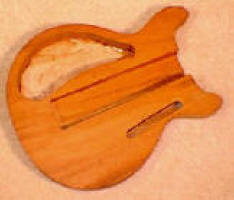 Q. How can you
get the 3/4 deep neck tenon set into an archtop style body? Q. How can you
get the 3/4 deep neck tenon set into an archtop style body?
A. It
simply can't be done using any normal or even computerized woodworking tools.
This of course means that PRS, Gibson, Ibanez, Jackson,
Duesenberg, BC
Rich, Hamer, Fender, G&L, or any of the other mainstream companies
will never do it. (It's way too expensive.)
To accomplish this feat you have to make a separate body and
a separate top. (Twice as much work.) Then you have even more work to
attach the two. First the pre-made body with a 12" mortise is attached to the
vacuum table. Then the pre-made neck with the 12" tenon is fitted directly into
the body. When that is all glued up, you then attach the pre-carved archtop
directly to the guitar.
Abstract uses only quartersawn Maple, Korina, Mahogany or
Premium Sapele for neck wood. Slab cutting (cutting the tree up into
pancake style pieces) works well for tops, backs, and veneers; but, it simply
isn't straight grained, strong or stable enough for a neck. If you ever
see a guitar with quilted neck avoid it like the plague. No matter how
pretty the wood is, I guarantee there will be huge problems with the neck.
IMPORTANT NECK INFO

It doesn't take a college degree to see which neck design is
the best. The Fender is a bolt-on neck. It attaches to a large
flange that sticks out from the body. It was designed half a century ago
and it is the hardest one to reach the top frets in the picture.
The Gibson Les Paul neck is not pictured here because I
simply didn't have a loose one to photograph. (What you need to know...)
The Gibson Les Paul neck is by far the shortest and stubbiest of all of them.
It butts up against the guitar at only the 16th fret. The remaining 6
frets lay on top of the body. I personally hate that design. Look at
a Les Paul from a side view. You will immediately notice how incredibly
short the neck is. This neck was also designed 50 years ago. It's
even harder than the Fender to reach the high frets.
See Why They All Break
Guitars are available in a set-neck, bolt-in neck, and even
deep-set neck tenon.
The Quicksilver & PRS necks are both designed in a
similar fashion. The Quicksilver neck is improved because it employs a
hard mount pickup cavity right in the neck; whereas, the PRS pickup only floats
on springs above it.
PRS necks and Quicksilver necks are both 25" scale and they
are completely interchangeable.

You Can Buy An Ed Roman Neck Click Here
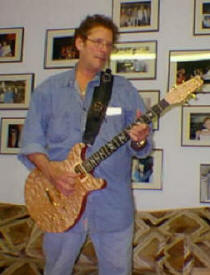
Look at this Abstract double cutaway guitar. The neck tenon actually extends to well below where
the bridge and tailpiece are positioned.
It is available in solid body, hollow body, or hollow body
with an F hole. The F holes are available in many different styles.
This guitar is our answer to Gibson's double cutaway guitar
from the early 60's. Available in neck thru body construction & bolt
in
|
Leslie West with
his Bluzeman.....
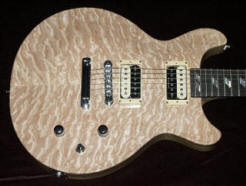
|
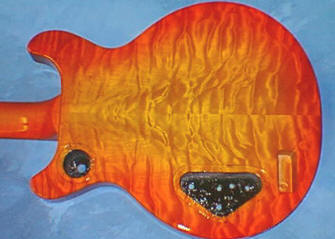
Quilted Back Option
The Quilted back is now available on most of our
guitars.
This option from Alembic is $1,500.00 just for the back
to match the front. PRS
charges $1,700.00 additional for this option. But PRS includes the top
also.
I try to give my customers an education on what items cost
from some of the larger companies.
Currently our prices are still way below our competition.
|

Notice the 5 piece super stable neck, you
can see it extending through the tremolo cavity.
The back and sides of this guitar are all quilted.
We could not do the neck in quilt because it would definitely break if we did.
|
Many Types of Neck
Construction |
|
Bolt-On |
Cheapest to manufacture, it has a unique tonal capability and
is very
common. Not recommended because the heel is too big. The
design is very old and the neck joint is cumbersome. Tonal abilities
are excellent as long as the neck is a very tight fit.
(Sometimes you have to play 30 of them before you get one that sounds good.) That will be the one
with the tight neck joint.
Fender, Ibanez, G&L, ESP, Ernie's Balls, Washburn, Charvel, most
imported guitars. |
|
Bolt-In |
Excellent alternative to bolt-on. Same excellent tonal ability, plus many of the
set-neck abilities. Very few companies offer it. Highly
recommended because the heel is buried in the body. In fact, I highly
recommend it over just a plain set-neck.
(Works best acoustically coupled.)
Currently
no other companies have this except PRS
& Quicksilver. Best for tone & sustain if the neck is tight & pickup is mounted directly in
the cavity. (Call for information--(702) 597-0147) |
|
Set-Neck |
Less expensive most common. I am not a fan of this
one. Are millions of
Les Pauls poorly designed & wrong? (A Very Definite YES !!!!)
Not recommended as highly due to limited tonal abilities. (Glue
does not transfer sound well.) Plus, set-neck guitars are the ones
that always break easily. Gibson, McInturff, Hamer, Warrior, Epiphone, Guild, Heritage, & many more.
PRS went to this antiquated design in 2007 Ouch, Take
a giant step backwards.
Click Here For
Details |
|
Neck-Thru |
Expensive & uncommon, I used to like this type the best until I
discovered Deep-Set Neck Tenon. (Pictured Below)
Highly recommended, due to much more sustain, plus pickups are mounted right in
the neck.
BC Rich, Jackson, Rickenbacker & Abstract.
Quicksilver Now Available Neck Thru |
|
Deep-Set Neck
Tenon |
Most expensive to do, not necessarily the most versatile sounding
and the most cosmetically appealing.
Very highly recommended due to same reasons as a neck-through, but with the
added attraction of keeping the top intact. You may sacrifice some
Strat and Tele tones but the blues tone is awesome. Rick Gledura,
Centurion, &
Quicksilver.
You
Can Buy An Ed Roman Neck Click Here
|

Quicksilver Neck Joint (middle) PRS Neck Joint (on each side)
It doesn't take a rocket scientist to see which one is the better one!
You Can Buy An Ed Roman Neck Click Here
By Using Standard
Quicksilver Parts We Can Improve
Your PRS 200%
|
The Best Of Both
Worlds
An Interesting Story About PRS & Other
Companies
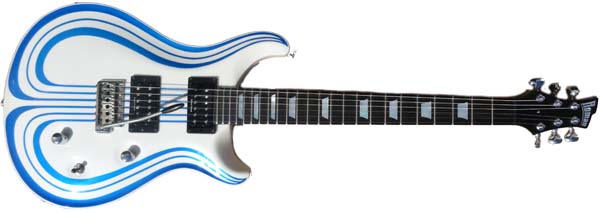
QUICKSILVER PRS HYBRID
<PRS & Quicksilver Have Sex & This Guitar Is Born>
Quicksilver Guitar With
Original Paul Reed Smith Body
These Two Brands Use Interchangeable Parts.
Ed Roman Has All Parts Available & In Stock
The Above Guitar Uses A Quicksilver Neck With Ebony Fretboard & Block
Inlays:
(Not available from PRS)
This Guitar Features An Original Brand New
1985 One Piece PRS Tremolo:
(No longer available from PRS)
This Also Features The Exclusive Quicksilver
Direct
Coupled Neck Mount System: Not
available from PRS)
It Also Features The Hard Mounted Pickups One In The Body & One In The Neck: (Not available from PRS)
Beautiful Pearl Paintjob By Ed Roman & Seymour Duncan
Blackback
Pickups
A Similar PRS Would Cost 3 to 4 Times As Much
Ed Roman Personally Guarantees
You Will Like This One Better !!!
THE PRS STORY BY ED ROMAN
I First Met Paul Reed Smith In The Mid 70's many many years
before he came out with the PRS line of guitars in 1985. His
first guitars were very expensive and really a bit overpriced
considering they were just OK. Any of those pre production
guitars today are worth a fortune to collectors, Not because of
their quality or looks but because of their pedigree & lineage.
Dateline 1985 Paul became a
real business with absolutely fabulous average priced guitars.
They were not very pricey and they really were great. In
fact they were miles ahead of anyone else they were absolutely
revolutionary !!!!
PRS Started Producing Guitars in 1985, Their Guitars Were The Best Money Could Buy.
In Fact They Were The #1 Guitar In My Book For The Ten Years Between 1985 & 1995
Which Is A Very Long Time For Any Company To Maintain That Top Position.
They
Employed An Exclusive One Piece Solid Cast Tremolo. These Tremolos Sell On
The Second Hand Market & Ebay For $750.00 With Wear On Them. Ed
Roman Has Acquired A Box Of Original Ones From One Of Paul's Original
Disgruntled Partners & Is Now Offering Them For A Limited Time On The
Quicksilver PRS Hybrid.
Originally PRS Guitars Used Some Of The Finest Tonewoods Available & Paul's
Designs Were Way Ahead Of The Curve. In Fact The Original Neck Joint Was &
Still Is A Major Stroke Of Genius.
Like Many Start Up Companies PRS Put All Their Focus Into Making The Absolute
Best Product They Could Make.
In Almost Every Case When A Brand Name Reaches A Certain Level Of Posterity The
Focus Moves Away From The Product & Starts To Concentrate On The Bottom Line.
It's An Old Story I Have Seen It With Gibson, ESP, Hamer, Dean & Too Many Others
To Mention.
It's Important To Keep In Mind, That This Is Just The Natural Order Of
Things. Usually The Owner Sells Out & Tries To Retire But When He Starts To See
What These Corporate Slime-Balls Are Doing To His Beloved Company They Try &
Start Over.
Sadly, They Almost Always Fail, Because They Are Older They Just Can't Afford To
Make The Sacrifices We All Have To Make When A New Company Is Started. I've Seen
This Happen Over & Over Again. When You First Start Up A Company You Could
Conceivably Go For Months Even Years With No Paycheck. I Know I Put Everything I
Had Back Into My Company.
I Feel I Have A Small Advantage Because I Have Realized This Before It Has
Happened To Me. If I Ever Sell My Company Which I Probably Won't I Will Demand
Control Over Quality & Design. Otherwise I Will Not Sell The Name.
Ed Roman
Below A Quicksilver Guitar With A PRS Neck
Too Bad PRS Doesn't Offer Ebony Fretboards !!!!
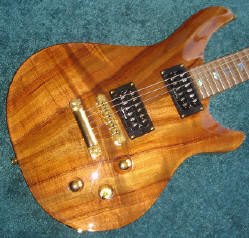 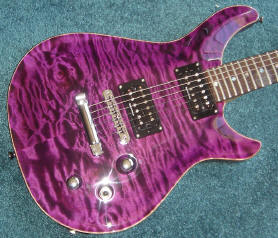
These 2 PRS Hybrid Guitars Are Available
Both Have Reduced Heels, Hard Mounted Duncan Pickups, Tone Pros Bridges, Push
Pull Pots
Korina & or Mahogany Backs, Koa Or Maple Top
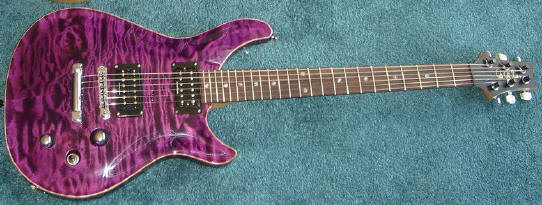
This guitar was custom re-made
from the ground up
Custom
Guitar Order Form
This is a full PRS conversion.
It started off as a boring opaque red PRS CE
with zero personality!!!
Improvements include, korina wood body, tone/pros, tune-O-matic bridge,
Duncan pickups, high grade quilt top,
1500G neck mod. heel removal, push pull pots, new Quicksilver body with slightly
longer upper bout for better balance. original PRS neck. |
|
PRS is still a pretty damn good guitar.
The fit, finish & basic quality easily surpasses Gibson, and most other corporate
guitar brands that are billed and sold as top quality, high end instruments.
The customer service, is usually much better than most other corporate
brands also.
However, the original 1985 excellent design, has been modified over the years
too
much !! In my opinion, there needs to be pretty major modifications made, to
make the present day PRS guitars as good as the originals! It
is easily possible to do that if you are lucky enough to have selected the
right model.
Originally, 25 years ago when PRS was
highly concerned about creating their original
excellent reputation, their guitars were far better than they are today. They
sounded better, played better, and looked better than what you can buy today. The ones you can buy today leave a lot to be desired. This speaks to our whole industry today. In fact there are very few companies
today that I can recommend wholeheartedly. These few
companies are JET,
Duesenberg,
Veillette, Abstract
Mosrite, Gretsch &
Quicksilver.
If you are reading this page in it's entirety, it's relative to
know that I personally own the Quicksilver & Abstract brands. Naturally the reader might
take this article as self serving. I of course have to grant you the fact that it is most
definitely self serving.
However, I am positive I can convince any relatively intelligent
open minded person, that the modifications needed to make a PRS better are effective and very
real !! In fact that these mods are already on the Quicksilver coupled with the
fact that the Quicksilver costs less!!!
Quicksilver's are superior by far. I hope to do it with facts
figures and downright common sense. No doubletalk, no mumbo jumbo.
|
Ramsey Elkholy's PRS Conversion
& Upgrade
Building A Much Better
Guitar !!!

I am exceptionally proud of how this guitar turned out !!!!
This is actually the original PRS 10 Top with the original
finish
We removed the original neck by heating the glue until it came out easily.
We custom made him a Brazilian Rosewood neck that is even thinner than an Ibanez
Wizard neck!!
 Ramsey's guitar came out awesome. Ramsey's guitar came out awesome.
Originally I had recommended an Ebony fingerboard but Ramsey insisted on the
Rosewood.
Nevertheless the guitar came out sounding at least 40% better than it did
originally.
The original neck was glued in, with the addition of the direct coupled bolted
in new neck
This guitar came out sounding like one of the best PRS guitars I have ever
played.
Another reason it sounded better was we removed the poly finish from the back of
the guitar.
This was the perfect guitar to do
these modifications to !!!
When Ramsey shipped us this guitar it
sounded awful, it had no sustain and the tone was dead.
He had tried everything to fix it.
|

He had completely destroyed the resale value of this
guitar !!!
By converting this to bolt in we
eliminated all the glue that was choking the tone !!
He
had added a third pickup which sounded bad until we redesigned the electronics
circuitry.
He drilled extra holes to accommodate all kinds of useless tone switches which
we also redesigned.
The neck on this guitar is now thinner & smaller than any Ibanez guitar we have
ever seen !!!
It plays as smooth as warm butter when we finished it.
Plus we came in several hundred dollars below his budget.
This is the perfect guitar for
someone who plays & doesn't care about originality !!
|
Thoughts & Commentary from Ed Roman
Before Ramsey started this project, I
advised him against it, I told him that it would make a lot more
sense to simply buy a Quicksilver new rather than try to
Quicksilverize his PRS. Well Ramsey
being a stubborn individual was Hell Bent on making his PRS sound
better, He had owned it for years and was very unhappy with all the
previous modifications. He was in search of the perfect tone. In a
way I can't blame him, if he had simply traded his PRS in and bought
a Quicksilver he could have saved several thousand dollars. If he
had bought a Quicksilver in the first place he could have saved
5,000.00 over the course of several years. Effectively he
would have ended up with the same thing.
Even though this guitar turned out to be one of the magical sounding
ones there is also the element of luck.
On his we got very lucky. The original mahogany body turned out to
be better than 95% of the PRS guitars we have seen and of course
removing the finish on the back really helped the sound immensely.
We learned a very valuable lesson doing his guitar and from now on
all of our customers are going to benefit from what we learned.
I believe that besides
converting this guitar to a bolt on the removal of the finish on the
back was the actual catalyst that made this guitar sound so good.
We are now offering
Quicksilver guitars in what we call a 3070 finish. Simply put
you can now buy a Quicksilver with a glossy top and an oil finished
back.
This is a very cost
effective modification for a PRS, we are already doing these 3070
mods several other PRS guitars and I have done it to my own
Quicksilver guitar. The difference is quite noticeable. |
|
IF YOU LIKE PRS GUITARS
!!!
YOU REALLY SHOULD READ THIS ARTICLE
Ed Roman Say's "Prove It"
Every company always says that their guitar is the best.
But nobody ever bothers to prove It !!!!
It�s as if they think consumers aren�t too bright,
I see a lot of image type advertising that I simply don�t
approve of. I believe that if someone says they build a better anything,
they had better be ready to prove it. (The ads for Gibson & Taylor
make me sick all image no substance.)
I have been in the music business for more than 37 years, I am or have been a dealer for over 400 different brands of guitars.
In fact I cannot think of any brands that I have never carried, except
maybe some obscure house brands, or something no one has ever heard of.
In almost every case every company says that
�Theirs Is The Best� Now anyone with even a
pea sized brain can realize that only one can be
�The Best�
In my opinion The Best Guitars usually come from small
boutique builders who build between 50 & 100 guitars a year. (That leaves
a lot of people out of the equation including some of my own brands)
Very Important�.. Just because someone builds a small
amount does not necessarily mean that their guitars are good. In fact I
have seen some incredibly poor examples of craftsmanship.
Design & Execution
Very few builders are capable of this, PRS for example
came onto the scene in 1985 with radical new designs and extremely good
execution. No one else even came close at the time. In fact no one came
close for more than 12 years.
PRS made the best guitar that I carried between 1985 and
1995 !!! I am ultra positive that no one made a better guitar during those
years !! Then horror of horrors they hooked up with one of Gibson's Ex
Presidents who became heavily involved with PRS and redesigned their
guitars. It seems that this guy, Ted McCarty, was the individual who's
name appeared on all the patents & trademarks of the Gibson company during
their glory days. To make a very long story short. These design changes
made the guitar more Gibson-esque and in my mind they ruined the guitar.
For a couple of years I had nothing to recommend to anyone as a really
great guitar except for used PRS guitars.
So, I sold my company "East Coast Music Mall," I then started
"Ed Roman's World Class Guitars" which was a company that would specialize
only
in used Pre 1995 PRS guitars.
I actually followed the business model of a friend of mine
from Florida, Jay Wolfe who at that time had a company that primarily specialized in
PRS used guitars.
Paul Reed Smith was and still is a far better guitar designer than
Ted McCarty but PRS changed all their new cool designs and great ideas
over to Ted's antiquated retro designs. Of course many uneducated guitar
players immediately went out and bought the McCarty designs thinking that
they must be good. After all this Jibroney had been with Gibson for years
and everyone knew PRS was a great guitar at that time.
In my opinion Ted McCarty made PRS a
household word and PRS became very famous but the instruments themselves
took a back seat to the bean counters as usual. They simply don't have the
original Mojo.
For example very few people don't
even realize that, Every one of the
Original PRS guitars (The Good Ones)
were all 24 fret and they either offered a
Mil Com Tremolo system or a
Tune O Matic bridge.
Today you cannot get anything but a
lightweight trem or that horrible wraparound bridge that even Gibson
abandoned except on their cheapest models. The 24 fret models are now only
available on their lesser expensive models unless you special order it
on a custom and pay huge additional money.
PRS has taken the stance that
their 22 fret guitars sound better. They have also taken the stance that
their glued in necks & wraparound non adjustable tailpieces sound
better, I strongly disagree.
And I must remind everyone again that PRS made their stellar reputation
building 24 fret models with small heels and no wraparound bridges.
How can they argue with that logic ???
Well don't ask me how or why but they do
!!!!
A good design must sound good be very playable and
preferably very
attractive. It must balance well and it should be comfortable seated or
standing.
|
|
The letter below is
one Ed Roman's personal favorites
Getting a letter like this one makes all the BS worthwhile
Ed
Wait till you hear this one. I recently bought a used PRS from my
local Guitar Center in Dallas. The salesman told me it was the best
sounding and playing PRS he had ever had in the store. It had a Tone Pros
Tun O matic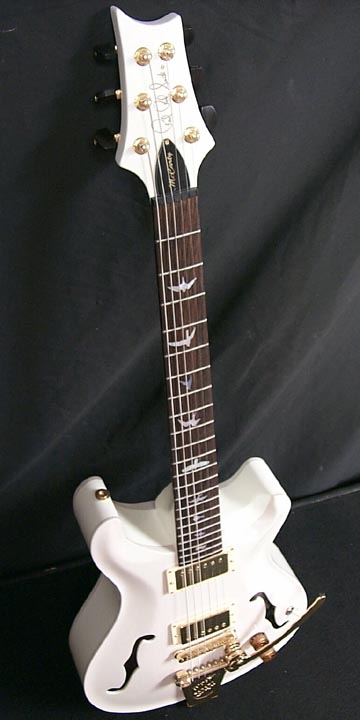 bridge
on it and the body was slightly slimmer than usual. The salesman at GC
told me (I think his name was Harry) said that the guitar was no ordinary
PRS, Supposedly it was made for someone in Creed blah blah blah (I found
out later that was an outright lie). Several other salespeople all agreed
that this guitar had the PRS magic and it was the reason why PRS had such
a good reputation. bridge
on it and the body was slightly slimmer than usual. The salesman at GC
told me (I think his name was Harry) said that the guitar was no ordinary
PRS, Supposedly it was made for someone in Creed blah blah blah (I found
out later that was an outright lie). Several other salespeople all agreed
that this guitar had the PRS magic and it was the reason why PRS had such
a good reputation.
I played the guitar and it truly did feel great, The neck was rock
solid and was incredibly highly figured. The body has a beautiful blue
flame top and a natural back. I sat there and tried about 12 PRS guitars,
The salesman was right, none of them came close. The guitar had almost
twice the sustain of any of the other ones and the neck was smoother and
faster.
Anyway I could not resist buying the guitar, In fact I had to borrow
most of the money from my bass player. They sold it to me for only
$800.00. The reason it was so cheap is there was no serial number on the
guitar and the PRS logo was not on the headstock. There were no bird
inlays but that was cool ! I was a little worried about buying a guitar
with no serial number and no logo but they gave me a fully paid receipt so
I figured it had to be OK.
The suited guy at the counter remarked that this guitar held tune
better than any other guitar he had ever played. He told me that I made a
very wise purchase and reassured me that I had made a good move. (He
didn't know how right he was).
I took the guitar home and I used it that weekend on a gig, It
performed superbly and I was one happy guy to say the least.
About a week after I got the guitar I discovered there was a push
pull pot on it and that it split the coils on the pickups. What a great
surprise. further fiddling around with it I noticed that the pickups were
bolted down solid instead of floating on springs like all the other PRS
guitars. I unscrewed the pickup and removed it and lo and behold there was
the inscription.
"Ed Roman Was Here." Everything I had
read on your website came tumbling back at me like a ton of bricks.
PRS Tone Pros
Conversion With Bigsby
This guitar appeared to have had a custom body not a PRS body, It
had the step route pickups like on your site and the neck has that
1500G system
that I read about on your site. The neck appears to be an original PRS but
I see now the modifications you made to the heel and the tongue where the
pickup bolts directly to it like a Quicksilver. That accounts for the
extra sustain! I am assuming there is a Buzz Feiten System on this guitar
because of the tuning stability.
I could probably sue Guitar Center for falsely representing this
guitar. But I am thanking them from the bottom of my heart because I have
one of the most awe inspiring guitars I have ever owned or for that matter
even played.
Whoever this guitar was originally built for might have
misrepresented it to Guitar Center but I am the luckiest guy in the world.
I was going to buy a PRS decal off that store in Cleveland that
sells them but now I would rather it said nothing.
Long Live Ed Roman
Pete Posintini
Plano TX
Note From Ed Roman
Hello Pete
Glad to see you like that guitar, I
originally rebuilt that PRS for a NYC police detective by the name of
Manny Poole, As I remember he lived somewhere in Jersey. The last time I
talked with him had been injured in the line of duty and was partially
paralyzed. So he must have sold it, I'm surprised it ended up in Texas. I
did a number of cool PRS rebuilds for Manny.
Several other things that you missed.
The guitar has a Korina Body and Seymour
Duncan Pickups, There were also 2 small stainless steel barrels inserted
in the tongue of the neck to add mass and stability.
The original PRS fingerboard had been
removed and a new ebony one was been installed. look carefully at the
frets you will notice you can't see the fret tangs on the side. look at a
regular PRS and you will see the tangs are
completely visible.
I usually sign the PRS mod's in the pickup
cavity and I usually Jokingly print " Ed Roman was here" Ala Kilroy was
here... Just a little private joke between myself and someone who will
remain anonymous right now.
If you want a letter or perhaps a copy of
the original invoice for the work please let me know.
Ed Roman |
|
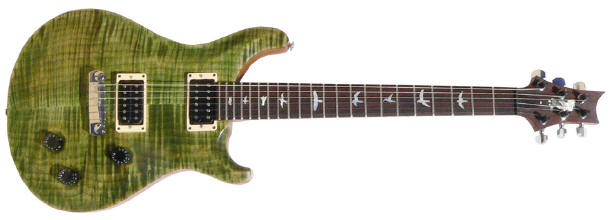
Totally Rebuilt From The
Ground Up
This is a later model 22 fret PRS and one
of the very few 22 fret ones that we have done major modifications on. This
guitar still uses the original body. The guitar had sentimental value to our
customer who spent more money than a new guitar to have us completely rebuild
and reconstruct his instrument.
1, This Guitar has been converted to a bolt in neck
2, We built the customer a new neck we
utilized the original fingerboard.
3, We hand inlaid the Eagle in the
headstock
4, We removed the poly finish and
restained the guitar the exact shade of green the customer wanted
5, We did an oil finish, short heel and
1500G Neck treatment.
6, We switched out the pickups and added
hard mounted Seymour Duncan Pickups.
7, We used our trademarked
neck mounting insert kit
to attach the neck super tightly.
It is rare that we do a job like this and
don't dump that wraparound bridge, but this was one of them.
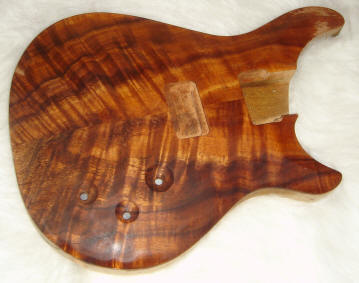
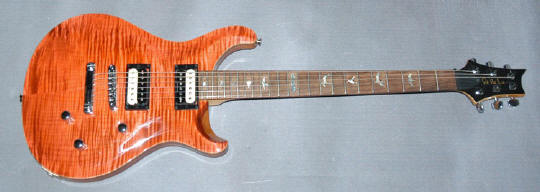
This is another PRS that thinks it's a Quicksilver
(See the bridge we installed)
Retopped Body, with Bird Inlays done at Ed Roman's
Personalized at the 12th fret
PRS does not offer nice tops or bird inlays on their bolt on models !!!!!
|
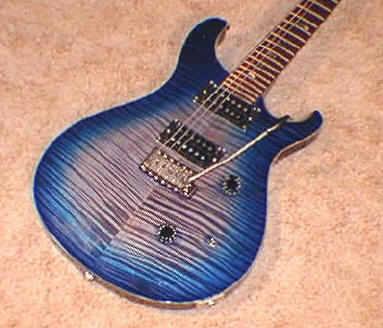
PRS Retop & Custom Paint Job
What you will read below I have said
before
about 20 times in 20 different ways in 20 different places.
I don't mean to be overly redundant but different readers read different
parts of the website.
If you are an avid reader of this site there will be little here you don't
already know !!!
|
Basic upgrades that need to be
made in order to improve the sound !!!
1, Remove the pickup mounting springs,
hard mount the pickups so that the vibration & resonance of the wood is not
compromised by the springs. this will require installing wood into the pickup
cavity. The tonal difference will be immediately apparent. You will hear more
overtones and it will sustain far better.
2, Remove the 4 wood
screws holding the neck on and mount 4 brass inserts into the neck. Re-attach
the neck using 4 hardened machine screws and inserts . This will tighten the neck joint more
than it was with the wood screws. The tone, especially the high end will be much
clearer and crisper. (Bolt In Models Only)
2a, The above paragraph pre
supposes that your PRS has a tight neck fit, About 80% of the PRS guitars have a
good tight neck fit. The original handbuilt ones were all excellent, however I
have found that on the newer production models tightness of neck fit can be
sporadic.
Proper neck fit means that you almost have to force the neck
into the neck pocket or mortise.
If your neck is a loose fit, then you are going to have to build
up the sides of the pockets with shims. Do not attach the shims with glue.
Glue acts as a deadener and in my opinion it has no place being anywhere near a
neck joint.
Exceptions are almost non existent to this rule.
The only exception I have
discovered is that when using a single coil soapbar style pickup a glued in neck
might complement the fatter single coil tone. Hence I only use a glued in
neck for Jazz style guitars and/or in situations where a soapbar pickup is
employed.
3, Converting the glue in neck models to a bolt on is not a job
for the weak of heart and not something that your basic guitar tech is going to
be able to pull off smoothly. It requires a great deal of work to remove the
glued in neck. It makes a fantastic difference tonally when the job is performed
correctly.
I am a strong believer that for music from the 60's to
present day there should be absolutely nothing in the neck joint but raw wood
touching raw wood, No paint, No Glue, No fillers of any kind. This will give you
the most resonant tone and allow your notes to bloom effectively.
|
 Early PRS custom
conversion guitar. Fine example of the first ever PRS lefthanded guitars. Early PRS custom
conversion guitar. Fine example of the first ever PRS lefthanded guitars.
Built in 1991 by Ed Roman's Custom
Shop using a stock PRS neck & hardware
We have done about 20 of these
since 1990 |
There are other theories of course but even though I have been flamed and called
vile names by a certain group of retro guitarists who own and play glued in neck
guitars. I have never received even one letter with a different theory. I have
built glue in neck guitars myself, and most of them came out sounding great. I
just wonder how much better they would have been if they were bolted in.
4,
Direct Coupling The Guitar is essential to improving the
sound It adds ton of tone & sustain.
5, Hard Mounting The Pickup in the Neck/Pickup cavity eliminates
the shaky sound and gives you much more sustain.
6, Replacing the cheap
Indian Rosewood fingerboard with
Ebony. This not only gives
you a much more percussive tone but it hold
7, Replace
The Pickups, I suggest using the Seymour Duncan Black/Backs
TM they were
developed over a 5 year period to be used in our LSR
guitars & Quicksilvers. They are available
and they sound great no matter what guitar you put them in.
8. Install Push Pull Pots
they will allow you to switch to single coil and or out of phase in an instant
and it doesn't affect your unity gain as much as the PRS 5 position knob. It's
quite a bit easier to use also.
9,
Change to the
Gold Adamantium Fretwire
which sounds like the nickel silver but wears like Stainless Steel.
Or you can simply purchase a
Quicksilver Guitar they all come with most of the above modifications as
standard
|
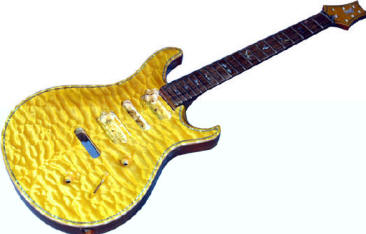 This is
yet another PRS that we retopped and refinished. We also
inlaid purfling around the entire body. I would have liked to redo the
fingerboard with ebony and do some really nice inlay work to it. This is
yet another PRS that we retopped and refinished. We also
inlaid purfling around the entire body. I would have liked to redo the
fingerboard with ebony and do some really nice inlay work to it.
Rosewood is
such a blah wood, it doesn't do much for the inlay. In fact
rosewood camouflages the abalone and tends to make even the prettiest abalone
look blah....We also inlaid an eagle on the headstock of this one. This
particular guitar was the 100th PRS we retopped. It was done for Winn Wilson of
Connecticut in 2001.
Today Ed Roman retops about 20 PRS guitars a year.
Back in the 90's we did about 50 a year. Today people just buy a
Quicksilver instead.
|
|
Improve Your Playability.
1, Remove the plastic finish on the back of the neck.
this will also improve your tone but that's only half of the modification. On
our 1500 G neck mod we sand & oil the neck in such a fashion that the friction
is greatly reduced. People really rave about how much they like this mod.
Click Here for more info.
2,
Remove the
Heel from Hell
that comes on the later models after 1995. The
early models (Pre 95) don't have that silly big heel on the base of the neck.
It's not very expensive to remove on the CE model and you will love the way the
guitar plays and feels after it has been removed.
Or you can simply purchase a Quicksilver
Guitar they all come with most of the above modifications as standard |

Removing the Heel From Hell on a PRS
Custom is a very common job
We have done 350 of these
We have done over 1000 on the CE Models

PRS
QUICKSILVER
PRS
No Heel
|
Basic upgrades that need to be
made in order to improve the cosmetics.
1,
Ebony fingerboards make your inlays show
much better !!!
2,
We offer
45 different types of wood for
the top of your guitar. See our PRS Retop Page
Gibson Retop Page
3,
Unlimited paint finishes imagine A
Rickenbacker Style Fire Glo on a PRS truly awesome, or a Metalflake job or
anything you can think of. We Do It All
Portraits, Themes, Flames,
Pinstriping etc etc
4,
We offer custom inlays including Dragons,
Vines, custom designs or anything
you can imagine
Or you can simply purchase a Quicksilver
Guitar they all come with most of the above modifications as standard |

Stock PRS body With Ed Roman Maple Top
As a large dealer of
Rock Star Owned Stage
Played Guitars I often come into contact
with many stock guitars that the artist simply does not want. In many
cases these guitars are given to them as a bribe to try to get them to
switch the brand that they play. I also get many heavily modified
customized guitars from these same individuals because they are used to
high quality and will not settle for the usual off the rack guitars.
There are people on the internet who would
flame me and call me a butcher for customizing many of the iconic guitars
but I must be in good company because offhand I cannot think of a single
pro guitarist that doesn't modify their guitars to suit them. |
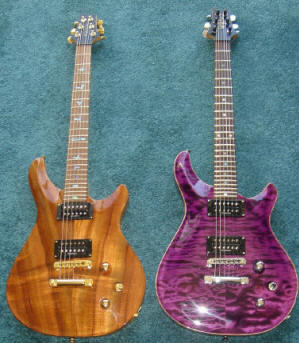
2 Beautiful PRS Conversions
They Play Better, Sound Better, Stay in Tune Better, Weigh Less & Look
Much Better.

Early PRS Retop Job
Tasmanian Blackwood

Come To Las Vegas
There is nothing like this fabulous city anywhere in the world !!!
Las Vegas is Home to Ed Roman Guitars
Come Meet Ed Personally
Let Ed design you the custom guitar you have always wanted.
Big Money Guitar Designers
Being a guitar designer I am always looking
for cool ideas, I recently found an incredible guitar designer from Switzerland.
Claudio Pagelli, his guitars sell for $50.000.00 I saw one sell at Namm
last year. Another amazing builder is Germany's Jerry Auerswald,
Jerry's guitars sell for much less only about $40.000.00 each. Jerry is
the guy who is building all those really cool "Prince Guitars" From what I'm
told these guys only build one of each model guitar. I am lucky to Have an
Auerswald guitar, I paid under $10,000.00 for it about 15 years ago.
I have put a few pictures below of some other
items designed by my all time favorite designer. Milano Italy's Luigi
Colani, He has never done a guitar but he has done almost everything else
from ladies shoes to Magnetic Levitation Trains, To Automobiles, To Urinals &
Bidet's, To Scissors, To Hovercraft. If you like his designs Google "Luigi
Colani" Prepare to be astounded
Ed
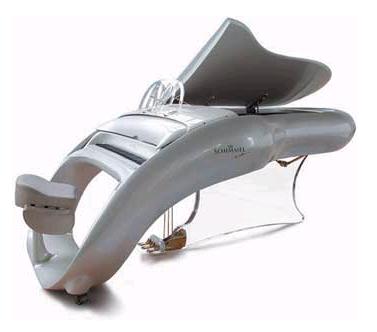
From Pianos To Cars To Urinals Colani
is my favorite designer!!
One of his famous quotes was
"There are no straight lines in the universe"
Ed Roman 2007
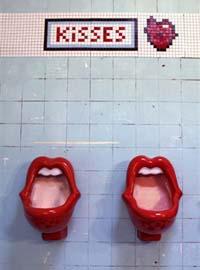
I am looking for cool Colani designs for my
collection of photos
Anyone who can help me. It would be appreciated
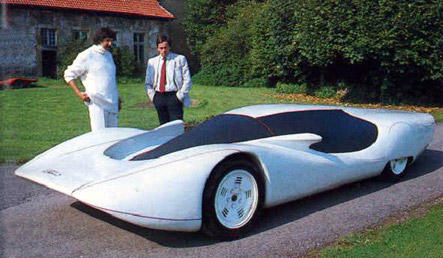
Colani BMW

Hovercraft By Colani

Colani Horch
Horch were the original cars that the Nazi
officers used as staff cars
They changed their name for publicity reasons to Audi

Luigi Colani Designer Extraordinaire
I would love to get him to design a guitar
Ed Roman

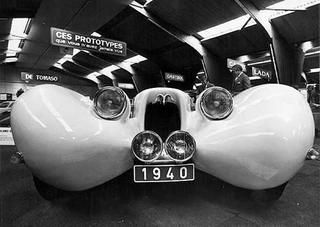 
Laiglon by Colani
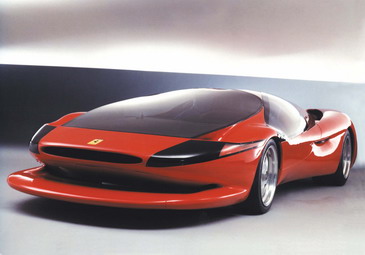
Colani Ferrari Experimental
|

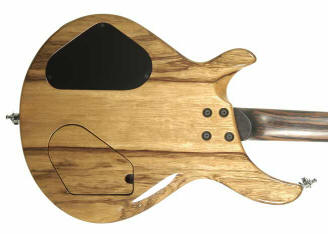 better because it usually costs more.
better because it usually costs more.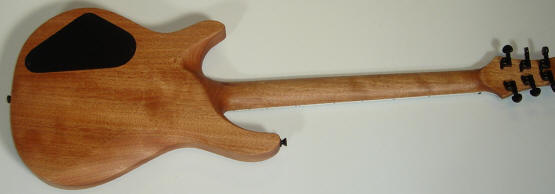
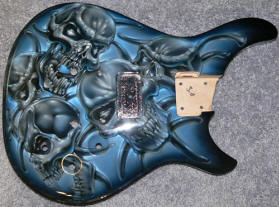
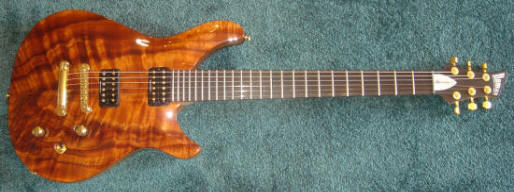
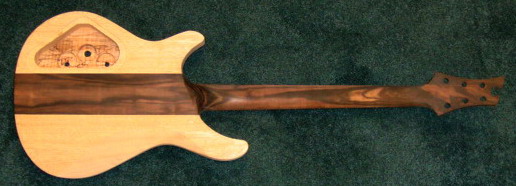



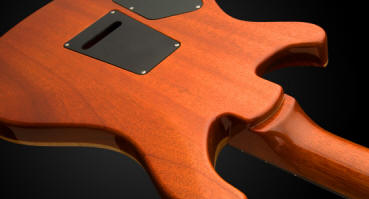

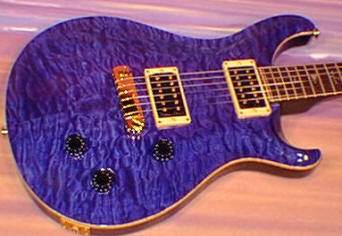


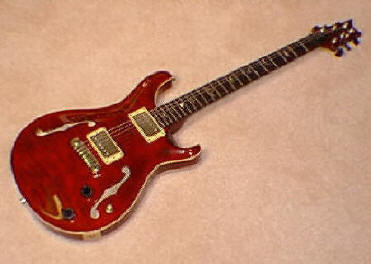
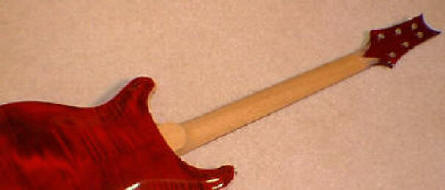
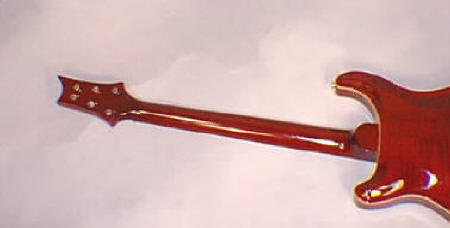

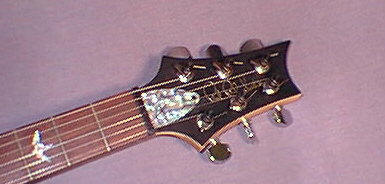

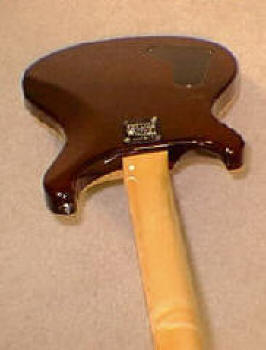
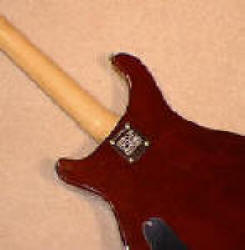
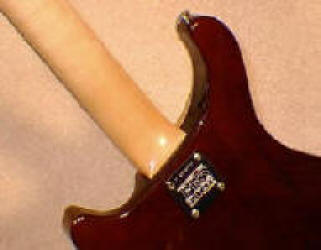

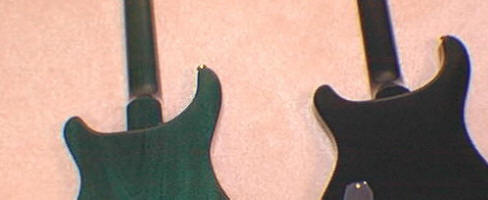
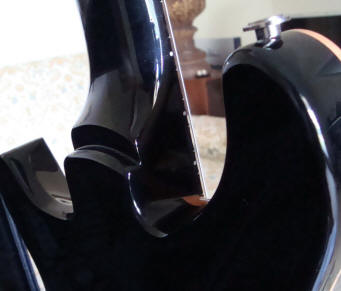
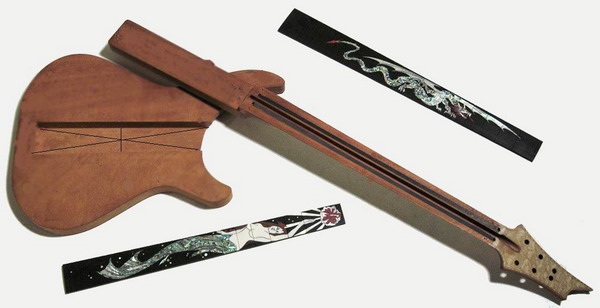

 Q. How can you
get the 3/4 deep neck tenon set into an archtop style body?
Q. How can you
get the 3/4 deep neck tenon set into an archtop style body?










 Ramsey's guitar came out awesome.
Ramsey's guitar came out awesome.
 bridge
on it and the body was slightly slimmer than usual. The salesman at GC
told me (I think his name was Harry) said that the guitar was no ordinary
PRS, Supposedly it was made for someone in Creed blah blah blah (I found
out later that was an outright lie). Several other salespeople all agreed
that this guitar had the PRS magic and it was the reason why PRS had such
a good reputation.
bridge
on it and the body was slightly slimmer than usual. The salesman at GC
told me (I think his name was Harry) said that the guitar was no ordinary
PRS, Supposedly it was made for someone in Creed blah blah blah (I found
out later that was an outright lie). Several other salespeople all agreed
that this guitar had the PRS magic and it was the reason why PRS had such
a good reputation. 



 Early PRS custom
conversion guitar. Fine example of the first ever PRS lefthanded guitars.
Early PRS custom
conversion guitar. Fine example of the first ever PRS lefthanded guitars. This is
yet another PRS that we retopped and refinished. We also
inlaid purfling around the entire body. I would have liked to redo the
fingerboard with ebony and do some really nice inlay work to it.
This is
yet another PRS that we retopped and refinished. We also
inlaid purfling around the entire body. I would have liked to redo the
fingerboard with ebony and do some really nice inlay work to it. 












